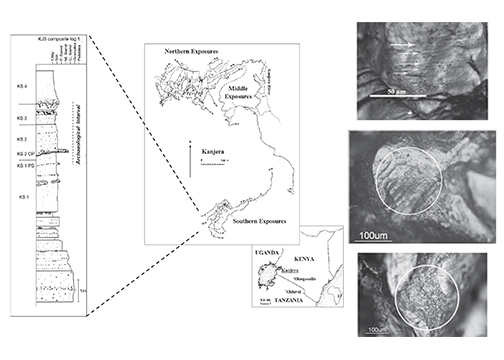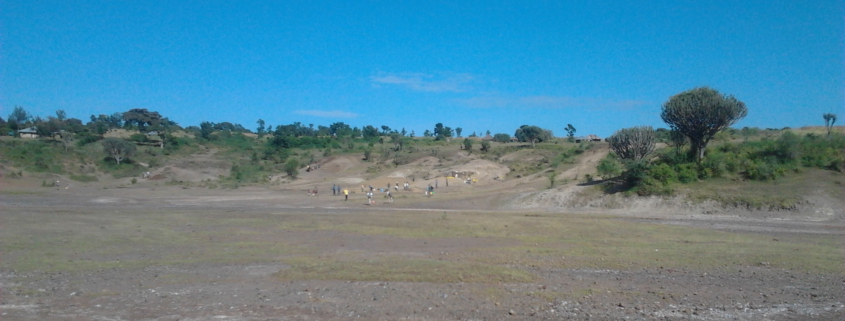Lower Paleolithic, Oldowan sites, Kenya
http://humanorigins.si.edu/research/east-african-research/
Sites excavation director: T.W.Plummer, Queens College, CUNY & NYCEP, NY, USA.
LTFAPA project: use-wear and residues analyses of chipped stone tools and macro-lithic tools of the Oldowan sites of Kanjera South, Nyayanga, Sari River.
The Homa Peninsula is a region located insouthwestern Kenya, reach in anthropic evidences of Early Stone Age. Three Oldowan sites, ranging from 2.600 – 2 Mya, are currently under study: the fully excavated site of Kanjera South and the two sites of Nyayanga and Sari River. The intensive survey and excavation of the archeological occurrences of the Homa Peninsula for more than two decades and the related analyses, allowed to obtain a detailed picture of the local paleoenvironment at that time, of the fauna exploitation, of the lithic raw material exploitation and the knapping techniques that hominins carried out to make lithic tools. Lithic raw material consists of a great variety of rocks (igneous, sedimentary, metamorphic and metasomatised), the 28% of which are non-local and collected in stream and river conglomerates no closer than 10-13 km from Kanjera South and Nyayanga. The core production modes change in relation to the exploited raw material. At Nyayanga, besides the chipped stone tools, macro-lithic tools, made of the same imported raw material, are present.

The great state of preservation of the lithic industry, extremely rare in so ancient contexts and probably caused by the fast deposition of the artifacts, allowed to set up a research project of use-wear analysis and residue analyses in collaboration with the National Museum of Nairobi.
Amazing data resulted from the use-wear analysis were already published in 2014 and 2019. Quartz, quartzite, rhyolite and fenetized chipped stone tools from Kanjera South were used not only for butchering but also for cutting and processing a variety of plants as wood, herbaceous plants and tubers. These data shed new light on the behavior of so ancient hominins suggesting that they were strongly familiar with plants exploitation.
The research project is going on with the analysis of the chipped stone tools and the macro-lithic tools of Nyayanga that are revealing extraordinary results now under publication.
References
Lemorini C., Plummer T.W., Braun D.R., Crittenden A.N., Ditchfield P.W., Bishop L.C., Hertel F., Oliver J.S., Marlowe F.W., Schoeninger M.J., Richard Potts R. (2014), Old stones’ song: Use-wear experiments and analysis of the Oldowan quartz and quartzite assemblage from Kanjera South (Kenya), Journal of Human Evolution, pp. 10-25. https://doi:10.1016/j.jhevol.2014.03.002
Lemorini C., Bishop L. C., Plummer T. W., Braun D. R., Ditchfield P W., Oliver J. S. 2019 Old stones’ song—second verse: use-wear analysis of rhyolite and fenetized andesite artifacts from the Oldowan lithic industry of Kanjera South, Kenya, Archaeological and Anthropological Sciences, volume 11, 9, pp 4729–4754. https://doi.org/10.1007/s12520-019-00800-z
Bishop, Laura C.; Plummer, Thomas W.; Braun, David R.; Ditchfield, Peter W.; Goble Early, Emily; Hertel, Fritz; Lemorini, Cristina; et al. (2022) Fauna and Paleoenvironments of the Homa Peninsula, Western Kenya Chapter 29 African Paleoecology and Human Evolution , pp. 360 – 375. https://doi.org/10.1017/9781139696470.029
Thomas W. Plummer, James S. Oliver, Emma M. Finestone, Peter W. Ditchfield, Laura C. Bishop, Scott A. Blumenthal, Cristina Lemorini, Isabella Caricola ….and and Richard Potts (2023) Expanded geographic distribution and dietary strategies of the earliest Oldowan hominins and Paranthropus, Science}, 379}, 663, 561-566}. https://doi.org/10.1126/science.abo7452.





